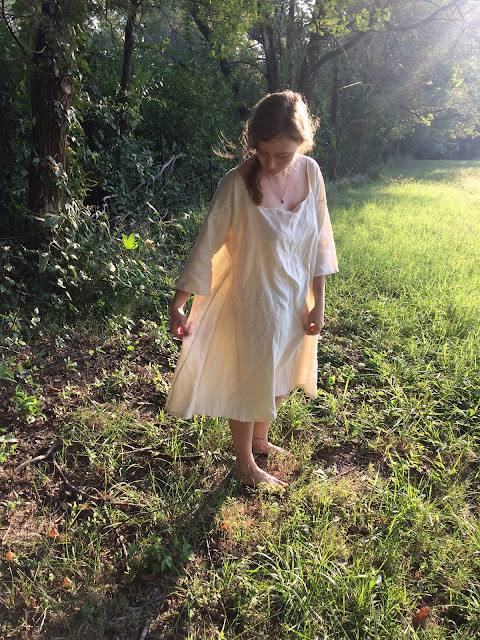Actually, I can't say that. I have made myself an 18th century garment, just one, and it took me nearly 5 months to make - a shift.
As I mentioned above, I've been wanting to make myself an 18th century ensemble for quite some time, and I've been gathering supplies for my endeavor. Now what's the first thing that must be completed when venturing into a new era of costuming? The undergarments, always the under garment - shifts, chamises, or combinations, stays or corsets, and petticoats. Without these things your finished garments won't have the right silhouette for your chosen era, and that silhouette is important! With the proper silhouette you can look like you stepped right out of the past. Thus, the undergarments must be made first, as tedious as that may be. Skin out. Shifts first.
Before the 19th century, nearly all undergarments were made from linen. With this in mind, I ordered a few yards of linen online, and when it arrived I chopped it up into my shift pieces - my 18th century project was finally beginning!
18th century shifts are really just a bunch of rectangles, and a couple rectangles cut in half diagonally to make triangles, so no true pattern is required. A quick google search for "18th century shift pattern" will bring up several blog posts, tutorials, and diagrams telling you how to cut a shift from a rectangle of fabric So, that's what I did, back in March. I googled it, found a diagram (I can't remember where now), took my measurements, and cut my linen into one long rectangle for the front and back of my shift, two smaller rectangles for my sleeves, two squares for underarm gussets, and 4 triangles (made by cutting narrow rectangles in half diagonally) for skirt gores. (I've actually made shifts in this manner in the past for my little sister)
That done, I set to sewing these geometric shapes together. By hand. Because, historical accuracy. I worked on sewing the shift while the kids I nannied were at gymnastics. It kept me occupied while I sat on the hard metal folding chairs in the parent's waiting area for an hour every Monday night. During that time, I got the seams all sewn. Next I had to flat fell all the seams, but then summer came, and I was no longer taking children to gymnastics every Monday night. My sewing basket, with the half done shift, got abandoned and forgotten about in a corner of my sewing room as summer insanity took over.
August came, and I was off on vacation. A few hours before leaving town I stumbled upon the abandoned shift in my sewing room, and decided to bring it along to finish up on the long car rides.
So, I sewed as we drove from state to state, and somewhere between home and the ocean, all the seams got flat-felled. Then, between the ocean and home, the shift got hemmed.
I used a hotel room iron to press the sleeve hems and the bottom hems. Once those were pressed and pinned in place, I did one last thing. I cut my neckline.
Up until this point the shift had been completely unwearable as it had no head-hole. I waited until the very end to cut one, as I didn't want it to stretch out of shape while I sewed the rest of the garment. The neckline is cut wide and low so it hopefully won't be seen underneath the gown I will eventually get around to making. It's finished with a narrow rolled hem.
Two states, and 10 hours from home, on our last day of vacation, I sewed the last stitch on my shift. 5 months after starting it.
Now I'm ready to get on with the rest of my ensemble! Next up, stays! And hopefully those won't take nearly as long as this did to finish, once I actually get started on them. But no promises.













Beautiful work! All those hand sewn flat fells must be very satisfying ; )
ReplyDeleteDoes linen feel different from cotton up close to your skin?
Linen feels much softer and gentler than cotton on the skin, almost like a fluffy silk. And it just keeps getting better with age, unlike cotton.
DeleteI just found your blog, looking up pindakaas dress (lovely) and enjoyed reading this post.... my goal is to figure out basic clothes patterns for myself that work (starting with shirt) then sew a bunch by hand in car, watching tv, out and about so I'm not chained to sewing machine. Curious what hand stitch you use for seaming...running stitch or back stitch? And how do you handle kinking up thread? Do you wax your thread? Use silk thread?
ReplyDeleteI wax my thread and that helps tremendously! Seams than will have stress on them are sewn with a back stitch. Seams that won't have much stress on them, such as long skirt seams, are sewn with a running back stitch (running stitch with a single back stitch every inch or so.
DeleteI really like your idea! Have fun with it!